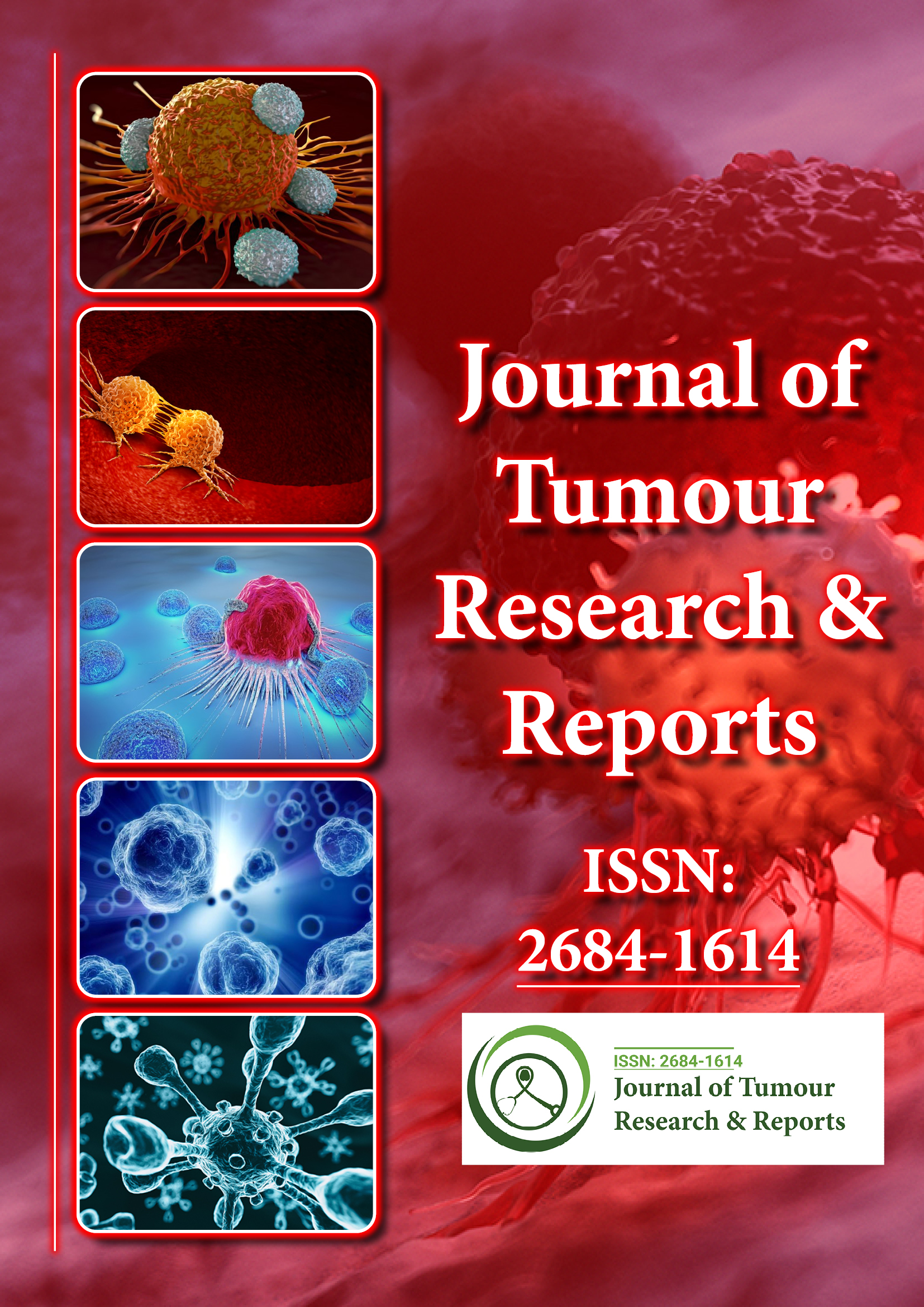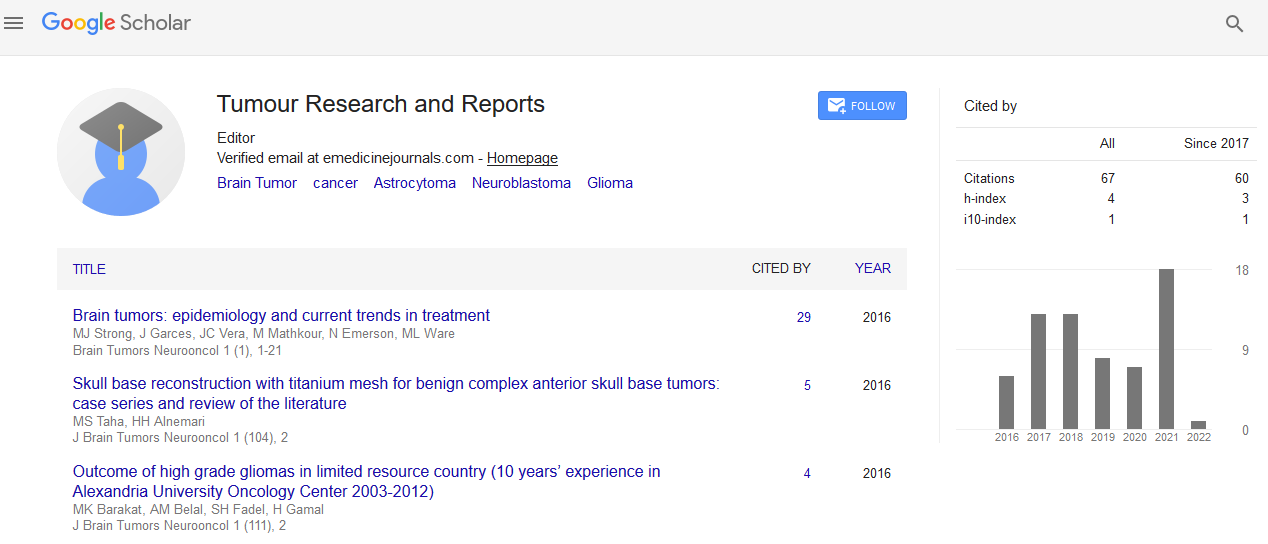Indexed In
- RefSeek
- Hamdard University
- EBSCO A-Z
- Google Scholar
Useful Links
Share This Page
Journal Flyer

Open Access Journals
- Agri and Aquaculture
- Biochemistry
- Bioinformatics & Systems Biology
- Business & Management
- Chemistry
- Clinical Sciences
- Engineering
- Food & Nutrition
- General Science
- Genetics & Molecular Biology
- Immunology & Microbiology
- Medical Sciences
- Neuroscience & Psychology
- Nursing & Health Care
- Pharmaceutical Sciences
Commentary - (2025) Volume 10, Issue 2
Emerging Perspectives on Tumour Microenvironment and Its Influence on Cancer Progression
Laura Mendel*Received: 30-May-2025, Manuscript No. JTRR-25-29815; Editor assigned: 02-Jun-2025, Pre QC No. JTRR-25-29815 (PQ); Reviewed: 16-Jun-2025, QC No. JTRR-25-29815; Revised: 23-Jun-2025, Manuscript No. JTRR-25-29815 (R); Published: 30-Jun-2025, DOI: 10.35248/2684-1614.25.10.254
Description
The study of cancer has undergone remarkable changes over the past decades, shifting from a focus solely on the malignant cell to a broader understanding that tumours are complex tissues influenced by their surrounding microenvironment. The tumour microenvironment (TME) refers to the collection of cells, molecules, blood vessels, and extracellular matrix that surround and interact with a tumour. It is increasingly clear that this dynamic environment not only supports but also drives cancer progression, influencing everything from tumour growth and metastasis to therapeutic resistance. For researchers, clinicians, and patients, this shift in understanding provides new opportunities and challenges in the fight against cancer.
Traditionally, cancer research concentrated on the genetic and molecular changes that occur within tumour cells themselves. Mutations in oncogenes and tumour suppressor genes were seen as the central drivers of malignant transformation. While this remains true, it became evident that these cells do not exist in isolation. Just as healthy cells depend on their surrounding tissue for signals and resources, so too do tumour cells rely on and manipulate their environment. The TME is composed of immune cells, fibroblasts, endothelial cells, signaling molecules such as cytokines and growth factors, and structural components like collagen and laminin. Each of these elements plays a role in shaping how a tumour behaves and responds to treatment.
One of the most striking aspects of the TME is its heterogeneity. Not all tumours create or respond to their microenvironment in the same way. Some recruit immune cells that attack and slow their growth, while others hijack these same cells to suppress the body’s natural defenses. Tumour-associated macrophages, for example, can be polarized into a pro-inflammatory state that targets cancer cells or into an anti-inflammatory state that supports tumour survival and angiogenesis. Similarly, cancer-associated fibroblasts produce extracellular matrix proteins and growth factors that enhance tumour growth, but in some contexts they may also restrain tumour expansion by forming physical barriers. This complexity makes the TME a double-edged sword and a fascinating subject of study.
Hypoxia, or low oxygen levels, is another critical feature of the TME. As tumours expand, they often outgrow their blood supply, leading to regions where oxygen delivery is insufficient. Tumour cells adapt by activating hypoxia-inducible factors (HIFs), which promote angiogenesis and alter cellular metabolism to favor glycolysis even in the presence of oxygen, a phenomenon known as the Warburg effect. Hypoxia also contributes to genetic instability and promotes resistance to radiation therapy, which relies on oxygen to generate DNA-damaging free radicals. Understanding and targeting hypoxic regions within tumours is therefore an important strategy for improving therapeutic outcomes.
The TME also has a profound influence on metastasis, the process by which cancer spreads to distant organs. The extracellular matrix provides both a barrier and a highway for invading cells. Enzymes such as matrix metalloproteinases (MMPs) break down the structural components of tissue, allowing cancer cells to migrate. At the same time, chemokines and growth factors create gradients that guide tumour cells toward blood vessels. Once inside the circulation, tumour cells must survive immune attack and physical stress before establishing new colonies in foreign tissues. The pre-metastatic niche, formed by bone marrow-derived cells and secreted factors, prepares distant sites to receive metastatic cells, underscoring the systemic nature of the TME.
Therapeutic resistance, one of the greatest challenges in oncology, is also heavily influenced by the microenvironment. Even when therapies are designed to target tumour-specific mutations, the surrounding stroma can provide alternative survival signals that shield cancer cells. For instance, interactions between tumour cells and fibroblasts may activate pathways that bypass drug-induced blockades. Immune checkpoint molecules expressed within the TME can suppress T cell activity, limiting the effectiveness of immunotherapy. Furthermore, abnormal vasculature within tumours can reduce drug delivery, while the extracellular matrix can act as a physical barrier. These layers of protection make the TME a major factor in why treatments sometimes fail even when they are well-designed.
Citation: Mendel L (2025). Emerging Perspectives on Tumour Microenvironment and Its Influence on Cancer Progression. J Tum Res Reports. 10:254.
Copyright: © 2025 Mendel L. This is an open-access article distributed under the terms of the Creative Commons Attribution License, which permits unrestricted use, distribution, and reproduction in any medium, provided the original author and source are credited.

